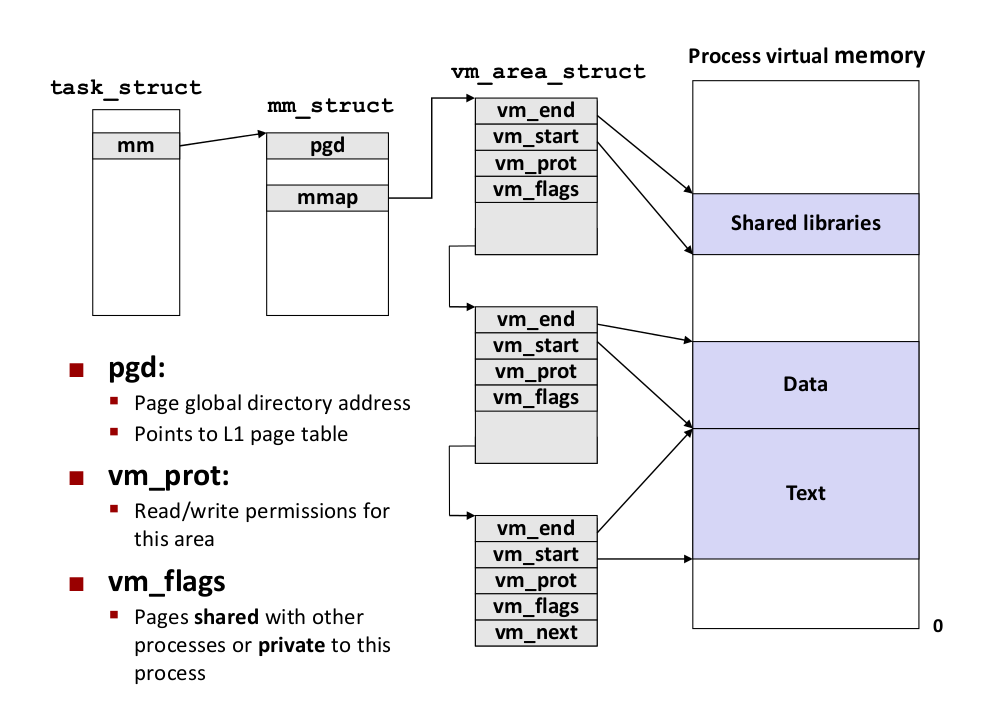- task_struct(v6.11.7) A Process(Thread) in Linux Kernel:
struct task_struct {
#ifdef CONFIG_THREAD_INFO_IN_TASK
/*
* For reasons of header soup (see current_thread_info()), this
* must be the first element of task_struct.
*/
struct thread_info thread_info;
#endif
struct mm_struct *mm;
...
pid_t pid;
...
/*
* Pointers to the (original) parent process, youngest child, younger sibling,
* older sibling, respectively. (p->father can be replaced with
* p->real_parent->pid)
*/
/* Real parent process: */
struct task_struct __rcu *real_parent;
/* Recipient of SIGCHLD, wait4() reports: */
struct task_struct __rcu *parent;
/*
* Children/sibling form the list of natural children:
*/
struct list_head children;
struct list_head sibling;
struct task_struct *group_leader;
...
/* Filesystem information: */
struct fs_struct *fs;
/* Open file information: */
struct files_struct *files;
...
...
/* Namespaces: */
struct nsproxy *nsproxy;
...
...
/* Control Group info protected by css_set_lock: */
struct css_set __rcu *cgroups;
/* cg_list protected by css_set_lock and tsk->alloc_lock: */
struct list_head cg_list;
...
/* CPU-specific state of this task: */
struct thread_struct thread;
};Memory (mm_struct)
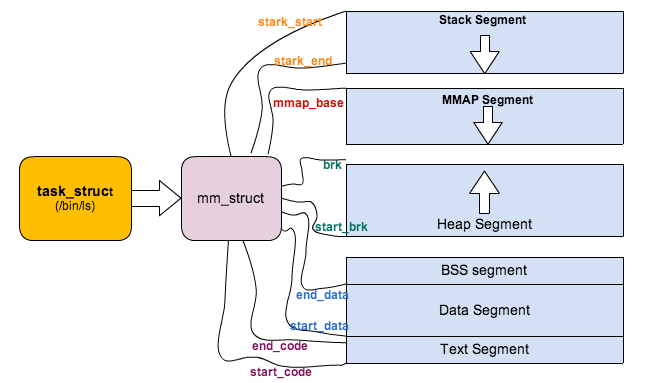
Before v6.1-rc1:
VMA(Virtual Memory Area)也用紅黑樹來紀錄追蹤頁面 (page) 變更,因為後者不免存在頻繁的讀取 VMA 結構,如 page fault 和 mmap 等操作,且當大量的已對應 (mapped) 區域時存在時,若要尋找某個特定的虛擬記憶體地址,鏈結串列 (linked list) 的走訪成本過高,因此需要一種資料結構以提供更有效率的尋找,於是紅黑樹就可勝任。
vm_area_struct is a doubly linked list, and rb_root is red black tree for faster query of a particular virtual memory address.
pgd is the address of the global page table.

start_code、end_code:starting and ending memory address of the code section.start_data、end_data:starting and ending memory address of the data section.start_stack:starting memory address of the stack section.start_brk、brk:starting and ending memory address of the heap section.arg_start、arg_end:starting and ending memory address of the function arguments.env_start,env_end:starting and ending memory address of the environmental arguments.
struct mm_struct {
struct {
struct vm_area_struct *mmap;
struct rb_root mm_rb;
...
pgd_t * pgd;
...
unsigned long start_code, end_code, start_data, end_data;
unsigned long start_brk, brk, start_stack;
unsigned long arg_start, arg_end, env_start, env_end;
};struct vm_area_struct {
/* The first cache line has the info for VMA tree walking. */
unsigned long vm_start; /* Our start address within vm_mm. */
unsigned long vm_end; /* The first byte after our end address
within vm_mm. */
/* linked list of VM areas per task, sorted by address */
struct vm_area_struct *vm_next, *vm_prev;
...
/*
* Access permissions of this VMA.
* See vmf_insert_mixed_prot() for discussion.
*/
pgprot_t vm_page_prot;
unsigned long vm_flags; /* Flags, see mm.h. */
Since v6.1-rc1:
- mm: remove rb tree.:Remove the RB tree and start using the maple tree for
vm_area_structtracking.
struct mm_struct {
struct {
struct maple_tree mm_mt;
...
pgd_t * pgd;
...
unsigned long start_code, end_code, start_data, end_data;
unsigned long start_brk, brk, start_stack;
unsigned long arg_start, arg_end, env_start, env_end;
};/*
* If the tree contains a single entry at index 0, it is usually stored in
* tree->ma_root. To optimise for the page cache, an entry which ends in '00',
* '01' or '11' is stored in the root, but an entry which ends in '10' will be
* stored in a node. Bits 3-6 are used to store enum maple_type.
*
* The flags are used both to store some immutable information about this tree
* (set at tree creation time) and dynamic information set under the spinlock.
*
* Another use of flags are to indicate global states of the tree. This is the
* case with the MAPLE_USE_RCU flag, which indicates the tree is currently in
* RCU mode. This mode was added to allow the tree to reuse nodes instead of
* re-allocating and RCU freeing nodes when there is a single user.
*/
struct maple_tree {
union {
spinlock_t ma_lock;
lockdep_map_p ma_external_lock;
};
unsigned int ma_flags;
void __rcu *ma_root;
};
/*
* This struct describes a virtual memory area. There is one of these
* per VM-area/task. A VM area is any part of the process virtual memory
* space that has a special rule for the page-fault handlers (ie a shared
* library, the executable area etc).
*/
struct vm_area_struct {
/* The first cache line has the info for VMA tree walking. */
union {
struct {
/* VMA covers [vm_start; vm_end) addresses within mm */
unsigned long vm_start;
unsigned long vm_end;
};
#ifdef CONFIG_PER_VMA_LOCK
struct rcu_head vm_rcu; /* Used for deferred freeing. */
#endif
};- Linux 核心設計: RCU 同步機制
- The Maple Tree, A Modern Data Structure for a Complex Problem
- The Maple Tree - Liam Howlett
Per Thread’s Stack
sp holds the start address of the stack pointer of the thread’s stack.
struct thread_struct {
/* Cached TLS descriptors: */
struct desc_struct tls_array[GDT_ENTRY_TLS_ENTRIES];
#ifdef CONFIG_X86_32
unsigned long sp0;
#endif
unsigned long sp;
...Process V.S. Thread

如果產生出來的 task_struct 有自己的 mm_struct,稱為 Process,其實本身就是個 Main Thread (CPU scheduling的基本單位)。如果 產生出來的 task_struct 共用別人的 mm_struct,稱為 Thread。
The Linux kernel does not provide any special scheduling semantics of data structures to represent threads. Instead, a thread is merely a process that shares certain resources with other processes.
若一個 task_struct 的 mm_struct = NULL,代表這個 task_struct 是一個 kernel thread。
Files
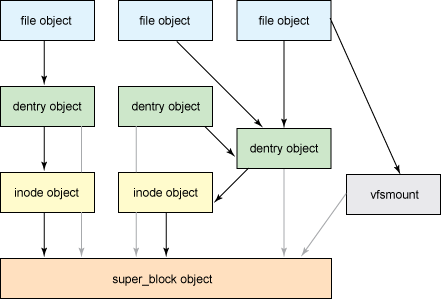

一個 process(task_struct) 有以下兩個 field:
/* Filesystem information: */
struct fs_struct *fs;
/* Open file information: */
struct files_struct *files;其中,fs_struct 代表這個 process 目前所使用的 file system 的 information,其中,每一個 path 都具有路徑(dentry)以及 mount 的相關資訊,包括 mount 在哪裡(dentry)以及這個 mounted 的 file system 的資訊(super_block)。
struct fs_struct {
...
struct path root, pwd;
} __randomize_layout;root path 和目前的 working directory struct fs_struct
struct path {
struct vfsmount *mnt;
struct dentry *dentry;
} __randomize_layout;struct vfsmount {
struct dentry *mnt_root; /* root of the mounted tree */
struct super_block *mnt_sb; /* pointer to superblock */
...
} __randomize_layout;dentry 代表路徑(directory),具有對應的 inode 的資訊。
struct dentry {
...
struct dentry *d_parent; /* parent directory */
...
struct inode *d_inode; /* Where the name belongs to - NULL is
* negative */
...
const struct dentry_operations *d_op;
struct super_block *d_sb; /* The root of the dentry tree */
...
};
super_block is the control block of the one specific file system. 可觀察到其具有一些屬性,包括 dev_t,也就是 device 的編號。
struct super_block {
...
dev_t s_dev; /* search index; _not_ kdev_t */
...
loff_t s_maxbytes; /* Max file size */
struct file_system_type *s_type;
const struct super_operations *s_op;
...
};struct super_operations {
struct inode *(*alloc_inode)(struct super_block *sb);
void (*destroy_inode)(struct inode *);
void (*free_inode)(struct inode *);
void (*dirty_inode) (struct inode *, int flags);
int (*write_inode) (struct inode *, struct writeback_control *wbc);
int (*drop_inode) (struct inode *);
...
};inode :inode (index node)是指在許多「類Unix檔案系統」中的一種資料結構,用於描述檔案系統對象(包括檔案、目錄、裝置檔案、socket、管道等)。每個inode儲存了檔案系統對象資料的屬性和磁碟塊位置。檔案系統對象屬性包含了各種元資料(如:最後修改時間) ,也包含使用者群組(owner)和權限資料。
struct inode {
...
const struct inode_operations *i_op;
struct super_block *i_sb;
...
};struct inode_operations {
struct dentry * (*lookup) (struct inode *,struct dentry *, unsigned int);
const char * (*get_link) (struct dentry *, struct inode *, struct delayed_call *);
int (*permission) (struct mnt_idmap *, struct inode *, int);
struct posix_acl * (*get_inode_acl)(struct inode *, int, bool);
int (*readlink) (struct dentry *, char __user *,int);
int (*create) (struct mnt_idmap *, struct inode *,struct dentry *,
umode_t, bool);
int (*link) (struct dentry *,struct inode *,struct dentry *);
int (*unlink) (struct inode *,struct dentry *);
int (*symlink) (struct mnt_idmap *, struct inode *,struct dentry *,
...
};
至於一個 process 的 open files,使用 files_struct 表示。
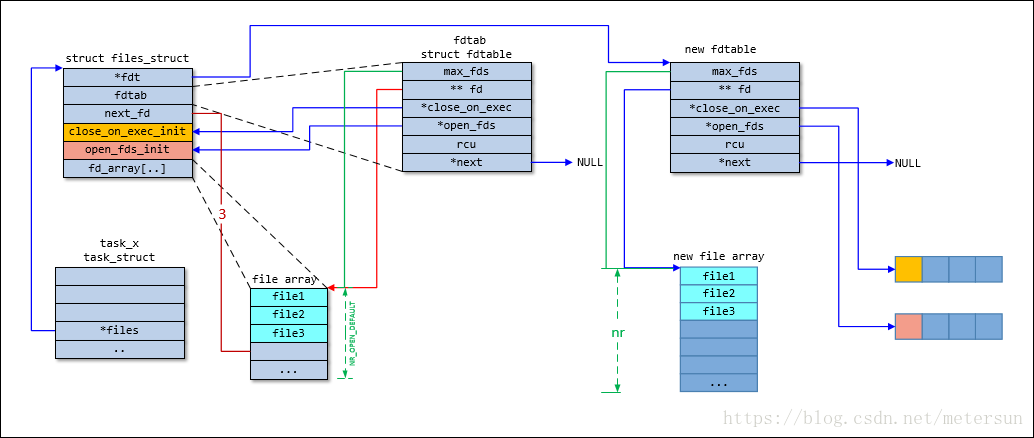
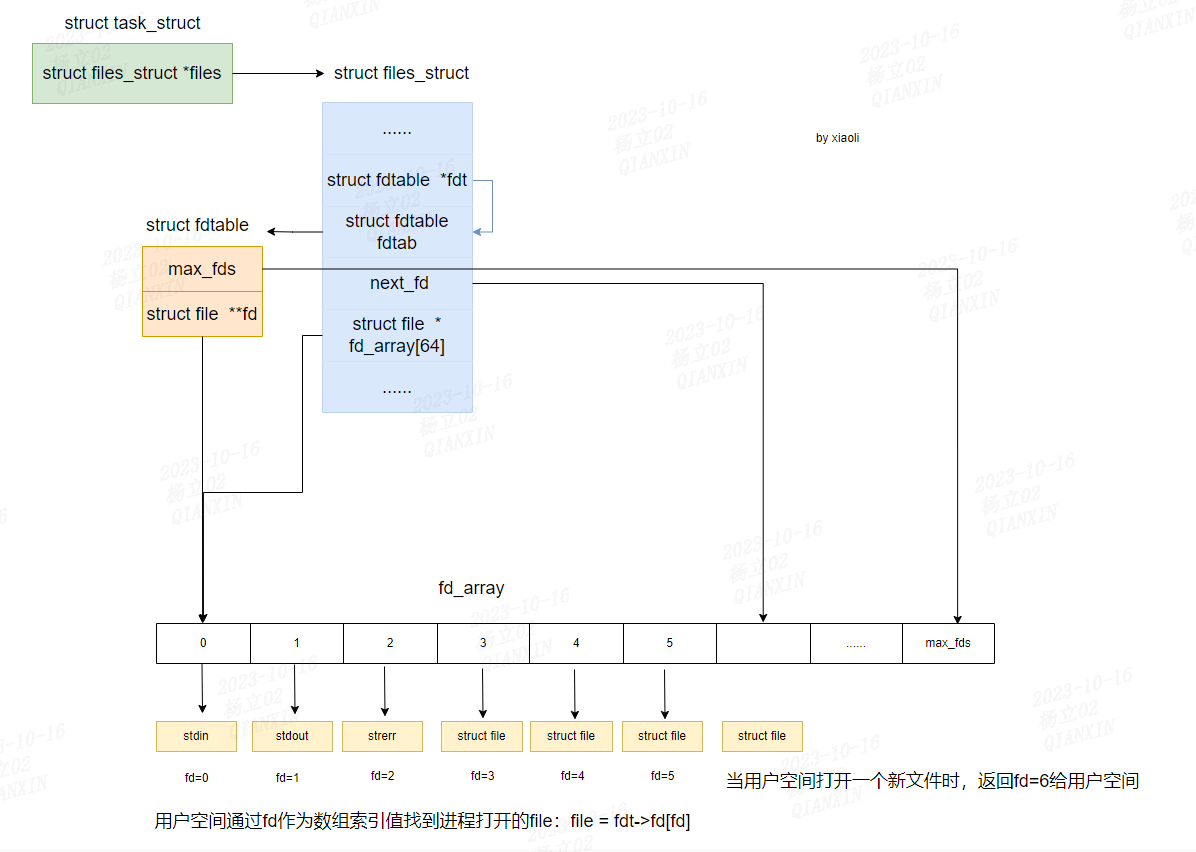
/*
* Open file table structure
*/
struct files_struct {
...
struct fdtable __rcu *fdt;
struct fdtable fdtab;
...
struct file __rcu * fd_array[NR_OPEN_DEFAULT];
};struct fdtable {
unsigned int max_fds;
struct file __rcu **fd; /* current fd array */
...
};fdt 為 per process 的 open file table( fdtable, file descriptor table),fdtab 為其備份。
如果一個 process 打開的 file 數目多於 NR_OPEN_DEFAULT (32 bit machine 上是 32個,64 bit 是 64 個),kernel 就會分配一個新的更大的 fd_array,並將其地址存放在fd 欄位中,而這個 fd_array 所包含的 file 數目存放在 max_fds 欄位。

一個 file 會具有其對應的 inode pointer。
struct file {
...
struct inode *f_inode; /* cached value */
const struct file_operations *f_op;
};struct file_operations {
struct module *owner;
loff_t (*llseek) (struct file *, loff_t, int);
ssize_t (*read) (struct file *, char __user *, size_t, loff_t *);
ssize_t (*write) (struct file *, const char __user *, size_t, loff_t *);
...
...
int (*mmap) (struct file *, struct vm_area_struct *);
...
int (*open) (struct inode *, struct file *);
int (*flush) (struct file *, fl_owner_t id);
int (*release) (struct inode *, struct file *);
...
};Namespaces and “containers”
A task_struct contains the following two fields, which is essential for implementing linux containers:
/* Namespaces: */
struct nsproxy *nsproxy;
...
...
/* Control Group info protected by css_set_lock: */
struct css_set __rcu *cgroups;/*
* A structure to contain pointers to all per-process
* namespaces - fs (mount), uts, network, sysvipc, etc.
*
* The pid namespace is an exception -- it's accessed using
* task_active_pid_ns. The pid namespace here is the
* namespace that children will use.
*
* 'count' is the number of tasks holding a reference.
* The count for each namespace, then, will be the number
* of nsproxies pointing to it, not the number of tasks.
*
* The nsproxy is shared by tasks which share all namespaces.
* As soon as a single namespace is cloned or unshared, the
* nsproxy is copied.
*/
struct nsproxy {
refcount_t count;
struct uts_namespace *uts_ns;
struct ipc_namespace *ipc_ns;
struct mnt_namespace *mnt_ns;
struct pid_namespace *pid_ns_for_children;
struct net *net_ns;
struct time_namespace *time_ns;
struct time_namespace *time_ns_for_children;
struct cgroup_namespace *cgroup_ns;
};